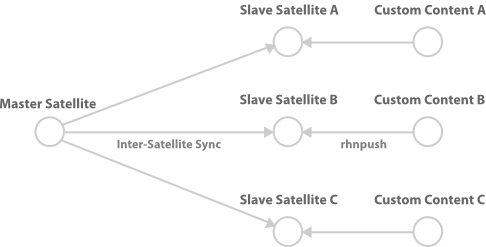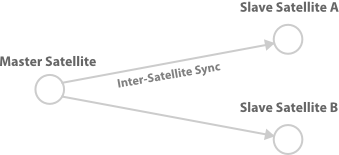6.4. Inter-Satellite Sync
RHN Satellite 5.3 or greater supports synchronization between two Satellites. This synchronization, also called Inter-Satellite Sync, allows administrators to simplify the process of coordinating content from one RHN Satellite source to another or several others.
The following are the basic requirements for Inter-satellite Sync.
- At least two RHN Satellite 5.3 or greater servers
- At least one RHN Satellite populated with at least one channel
- Master RHN Satellite SSL certificate available on each of the slave RHN Satellites for secure connection
6.4.1. Recommended Models for Inter-Satellite Sync
Copy linkLink copied to clipboard!
The Inter-Satellite Sync feature for Satellite provides facilities for synchronizing content between two or more Satellites. The following are some of the more typical uses that show the possibilities of Inter-Satellite Sync and help guide you in determining how to make the most of this feature in your environment.
Note
If you are not sure if the Inter-Satellite Sync feature is right for your organization, please note that you can continue to use RHN Satellite 5.3 or greater in the typical manner. Installing or upgrading to RHN Satellite 5.3 or greater does not require that you make use of this feature.
Figure 6.1. Staging Satellite
In this example, the Stage Satellite is used to prepare the content and perform quality assurance (QA) work — to make sure that packages are fit for production use. After content is approved to go to production, the Production Satellite will then synchronize the content from the Stage Satellite.
Figure 6.2. Master Server and Slave Peers that include their own custom content
In this example, the master Satellite is the development channel, from which content is distributed to all production slave Satellites. Some slave Satellites have extra content not present in master Satellite channels. These packages are preserved, but all changes from master Satellite are synchronized to Slave Satellite.
Figure 6.3. Slave Satellites are maintained exactly as the master Satellite
In this example, the master Satellite (for example, a software or Hardware vendor) provides data to its customer. These changes are regularly synchronized to slave Satellites.


